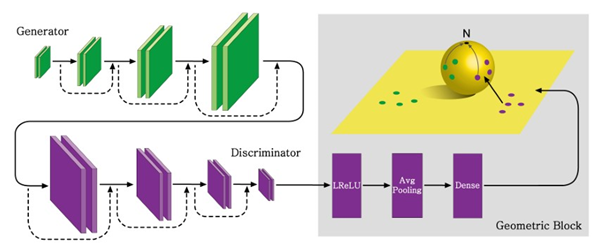우수연구성과
SphereGAN: Novel and Improved Neural Network Developed by Researchers from Chung-Ang University
SphereGAN: Novel and Improved Neural Network Developed by Researchers from Chung-Ang University
Researchers develop a simple and effective generative adversarial network known as SphereGAN for unsupervised image generation
Neural networks, widely used for object
recognition and segmentation, have multiple applications in cybersecurity,
social media, and healthcare. Researchers from Chung-Ang University recently developed
a novel generative adversarial neural network (GAN) based on Riemannian geometry,
which overcomes multiple disadvantages of existing state-of-the-art GANs. This
GAN, known as SphereGAN, demonstrates greater accuracy in 2D and 3D image generation
and processing applications.

SphereGAN
SphereGAN is a simple yet effective neural network
with superior performance for image generation and segmentation based on
Riemannian geometry
Image courtesy: Junseok Kwon from Chung-Ang
University
Usage restrictions: Cannot be reused without permission
Deep neural networks are popularly used for object recognition, detection, and segmentation across different avenues. Of these, generative adversarial networks (GANs) are a superior class of neural networks whose performance exceeds that of conventional neural networks. They are meant to minimize the inconsistencies between real and fake data, and have proven successful for image detection, medical imaging, video prediction, 3D image reconstruction, and more.
Despite their growth over the last few years, they are not devoid of limitations. Training conventional GANs is difficult and involves very high computational costs, making them unreliable for complex computer vision problems. In addition, the data generated by them lacks diversity and appears unrealistic. Thus, it is not surprising that many GANs are unstable and can only handle simple data sets.
To overcome these limitations, a team of researchers including PhD student Sung Woo Park and Professor Junseok Kwon from Chung-Ang University in Seoul conducted a study with a simple solution. This study, published in IEEE Transactions on Pattern Analysis and Machine Intelligence, was made available online on August 12, 2020, and was published in Volume 44 Issue 3 of the journal on March 1, 2022.
In this study, the team proposed a simple and effective integral probability metric (IPM) based GAN known as ‘SphereGAN’. SphereGAN uses multiple geometric moments to examine the inconsistencies between real and fake data distributions on the surface of a ‘hypersphere’. A hypersphere is a sphere with multiple dimensions which belongs to a branch of mathematics known as Riemannian geometry. “Compared to the trends of conventional generative models, we tried to bridge machine learning with the well-known sub-area of mathematics known as 'Riemannian geometry’, since it has many positive implications for mathematical data,” said Prof. Kwon, explaining their motivation behind this unique approach.
They found that by incorporating Riemannian geometry in this model, SphereGAN demonstrated a considerably improved performance as compared to conventional GANs.
For starters, it could be mathematically verified, was found to undergo stable training, and was successful in generating realistic images. Moreover, it displayed superior mathematical properties which eliminated the need for additional processes such as virtual data sampling—a necessary requirement for conventional GANs. SphereGAN also used multiple geometric moments, which improved its accuracy in measuring distances—an important aspect of image generation.
On testing this model’s efficacy for unsupervised 2D image generation and 3D point cloud generation, the team observed that the resultant 2D images and 3D point clouds were more realistic than those produced by conventional GANs, regardless of the domain of the dataset.
What are the long-term implications of using SphereGAN? “GANs have been employed for numerous applications the industrial fields, such as the generation of ‘deep fake’ images,” explains Prof. Kwon. “The difference between these fake images and real ones cannot be distinguished by human perception. In the coming years, these and more advanced image generation applications will be possible with a robust model like SphereGAN”.
Looks like SphereGAN will truly revolutionize imaging applications for multiple industrial and research fields in the coming years!
Reference
|
Authors
Title of original paper
Journal |
Sung Woo Park and
Junseok Kwon* SphereGAN: Sphere Generative Adversarial Network Based on Geometric Moment Matching and its Applications IEEE Transactions on Pattern Analysis and Machine Intelligence |
|
|
|
|
DOI
Affiliations |
School of Computer Science and Engineering,
Chung-Ang University, Seoul 06974, South Korea |
*Corresponding author’s email: pswkiki@gmail.com, jskwon@cau.ac.kr
About Chung-Ang University
Chung-Ang University is a private comprehensive research university located in Seoul, South Korea. It was started as a kindergarten in 1918 and attained university status in 1953. It is fully accredited by the Ministry of Education of Korea. Chung-Ang University conducts research activities under the slogan of “Justice and Truth.” Its new vision for completing 100 years is “The Global Creative Leader.” Chung-Ang University offers undergraduate, postgraduate, and doctoral programs, which encompass a law school, management program, and medical school; it has 16 undergraduate and graduate schools each. Chung-Ang University’s culture and arts programs are considered the best in Korea.
Website: https://neweng.cau.ac.kr/index.do
About Professor Junseok Kwon
Dr. Junseok Kwon is an Associate Professor at the School of Computer Science and Engineering at Chung-Ang University. He received her Ph.D. in electrical engineering and computer science from Seoul National University in 2013. He primarily works to develop and improve object tracking to capture the dynamics of cities. His research interests lie in computer vision and deep learning, focusing on visual tracking, visual surveillance, and the Monte Carlo sampling method and its variants. He has contributed to over 80 publications and his work is well recognized within the research sphere.
